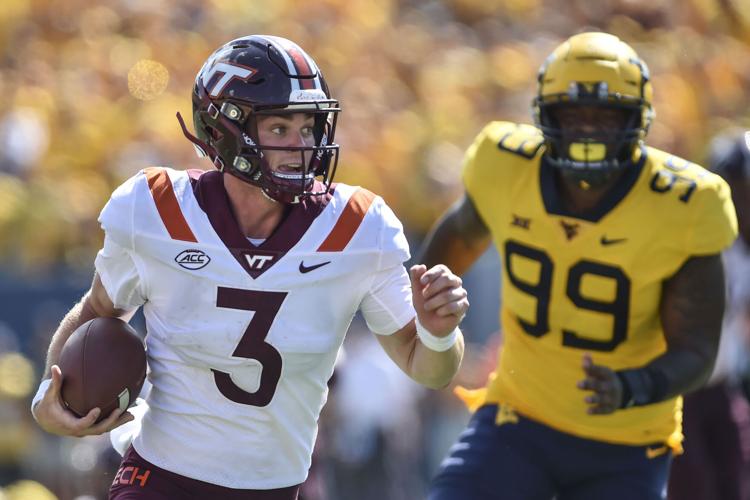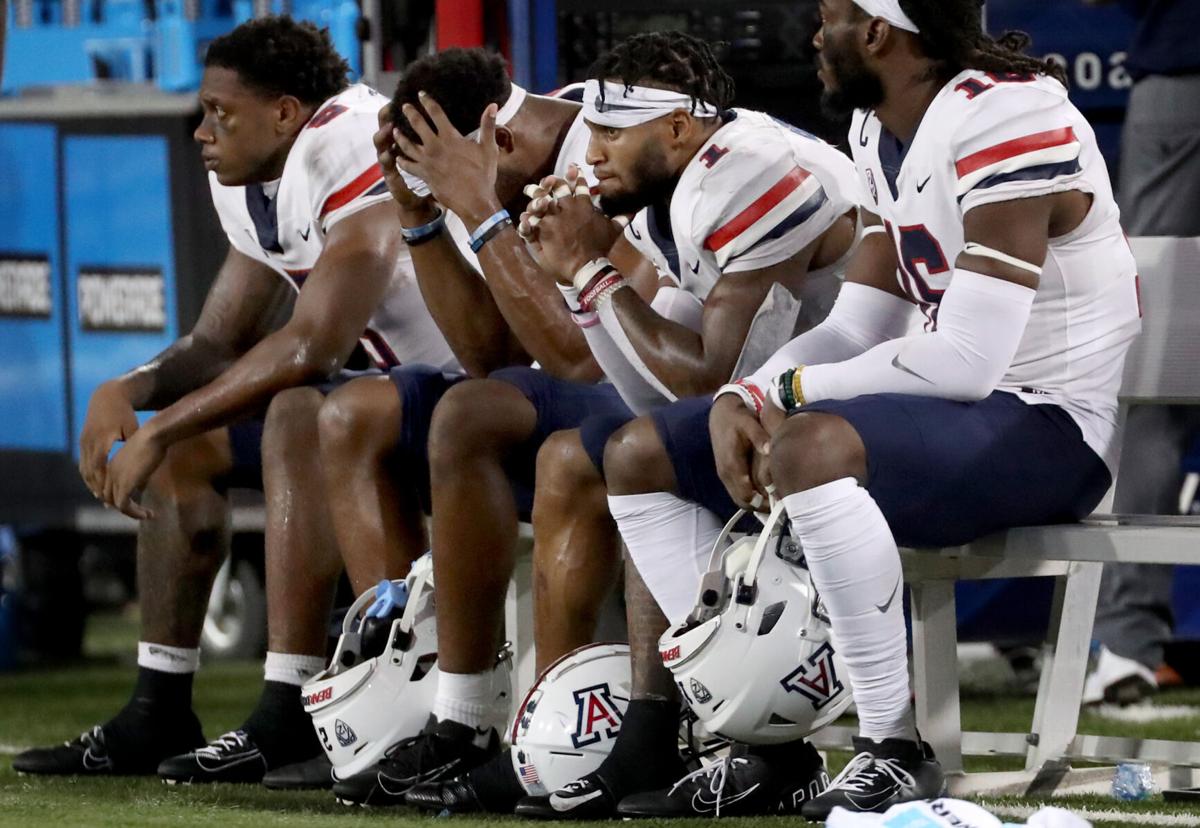Dear Mr. Football: How do you know when you are a “basketball school?”
A: The Power 5 schools with the most losing football seasons from 2000-20 are mostly a lineup of basketball bluebloods.
18 seasons: Indiana and Vanderbilt
17 seasons: Kansas (with 12 straight losing seasons) and Illinois
16 seasons: Duke
15 seasons: Colorado
13 seasons: Rutgers and Washington State
12 seasons: Arizona
Whatever the label, it’s not a good list to be on.
Dear Mr. Football: How rare is it for a college football team to fail to score at least 20 points in six consecutive games, as Arizona has?
A: In 1982-83, the Oregon Ducks went 10 games without hitting 20. The Ducks ended the ’83 season in a 0-0 tie against Oregon State, which a year earlier set the modern Pac-12 record by going 16 consecutive games without scoring 20 points.
What’s amazing about the end of the ’83 season and the infamous 0-0 Beavers-Ducks tie is that Oregon did not fire head coach Rich Brooks. It was the end of his seventh season at Oregon; his record was 24-49-4.
That’s a fireable offense in 21st century football. No one today gets seven years to get it right.
Dear Mr. Football: How did Oregon ever become a national power after that grim period?
A: Most would say it can be traced to the infusion of wealth Nike’s Phil Knight began showering on his alma mater in the mid-1990s. But I fully believe that Knight’s collaboration is only No. 2. Not firing Brooks is No. 1.
Oregon athletic director Bill Byrne, father of former Arizona AD Greg Byrne, was wise enough to realize that Oregon wasn’t going to be able to find a better coach than Brooks. In fact, on the day Oregon hired Brooks in December 1976 — the UO chose him over his fellow UCLA assistant coach Dick Tomey, as well as San Diego Chargers assistant coach Bill Walsh — then-Oregon athletic director John Caine said, “We would’ve liked to have gotten a big name but those people aren’t interested in a down program.”
Brooks was. The Ducks (and Beavers) had the worst football facilities in the Pac-10 and both were considered basketball schools.
Byrne stuck with Brooks because he saw something that outsiders didn’t: Brooks was a tough sonofagun, a defense-first talent-developer who had put the bricks in place to make Oregon a .500 team, or better. That was preferable to firing head coaches every few years like Oregon State did in the ’70s, ’80s and ’90s.
It continued to be a slow climb for Brooks, a likeable man with a winning personality whose teams were among the most physical, toughest outs in Pac-10 football. He was the epitome of a “make the most out of what you’ve got” coach. After the ’83 debacle, the Ducks went, in succession, 6-5, 5-6, 5-6, 6-5 and 6-6. Byrne saw progress where others saw “same-old, same-old,” the words Arizona used when it parted ways with Tomey in 2000.
Dear Mr. Football: When did sticking with Brooks finally pay off?
A: In 1994, the Ducks stunned No. 11 Arizona, 10-9, in what remains the most costly loss in Arizona football history. Oregon went to the Rose Bowl. Arizona’s all-too-brief “Desert Swarm” period would soon be at an end.
Brooks attracted so much attention for finally getting Oregon to a championship — he had gone 8-4 and 8-4 a few seasons earlier — that Knight became active in funding the future of Oregon football. Brooks? He was hired to be the head coach of the NFL’s St. Louis Rams.
It took 18 years of old-fashioned sweat, tears and sticking-to-it, but that’s what Oregon required to finally become relevant in football. I consider Brooks and Washington State’s Mike Price — he coached the Cougars to two Rose Bowls — the two most accomplished coaches in modern Pac-12 history. Do you think Pete Carroll could’ve coached Oregon and WSU 1990s-type talent to a Rose Bowl? Me neither.

The hard-working, likable Rich Brooks built Oregon’s program before taking on a similar rebuilding project at Kentucky.
Dear Mr. Football: Whatever happened to Brooks?
A: After two years as the Rams head coach and four years as an assistant with the Atlanta Falcons, Brooks called me a few days after Tomey was fired in 2000. He asked if I thought Arizona would consider him as Tomey’s replacement.
I’m no athletic director, but I told him Arizona couldn’t hope to get a more qualified coach. Brooks was 59. He had 10 good years left. He knew exactly how to take Arizona back to prominence, but the UA viewed Brooks as too much like Tomey.
The Wildcats hired fired Texas coach John Mackovic. Thus began the 20 worst seasons (112-141) of Arizona football since the 1950s. In 2003, woebegone Kentucky hired Brooks, then 62. Kentucky had produced two winning seasons in 13 years, but Brooks knew exactly how to feed a football-starved school.
After building with toughness and energy for three seasons, Brooks’ Kentucky teams went 30-22 with four consecutive bowl games. Although Brooks is now 80, retired and living in Oregon, he could make a difference as a consultant to the head coaches at football-challenged schools like Arizona, Vanderbilt, Colorado and Illinois.
Dear Mr. Football: What was Jedd Fisch’s most spot-on pledge after Arizona lost to NAU?
A: Fisch said he hopes to emulate Adia Barnes’ reconstruction of the UA women’s basketball program. If you think losing to NAU is time to check out and jump off the Fisch bandwagon, it might be wise to remember that Barnes also lost to the Lumberjacks at the outset of her second season, 2017-18, by an 84-66 score in Flagstaff.
The NAU women’s basketball team of ’17-18 was awful, finishing 7-23 while losing to Cal Poly, Grand Canyon, Youngstown State and Cal State Northridge. Arizona finished 6-24. That’s as low as you can go in college sports, isn’t it?
But in Year 3, Barnes’ Wildcats won the WNIT, sold out McKale Center and began a path toward the 2021 national championship game in her fifth year. If Fisch can indeed emulate even 70% of Barnes’ success, he’ll be carried off the field someday soon.

Former UA commit Braxton Burmeister played at Oregon before transferring to Virginia Tech, where he was the Hokies' starting quarterback in 2021. He's now at San Diego State, and will line up against the Wildcats on Saturday.
Dear Mr. Football: In the everlasting search for a franchise-type quarterback, where should Arizona look?
A: How about Oregon? The NCAA transfer portal has been loaded with ex-Oregon quarterbacks who are productive this year. Virginia Tech’s Braxton Burmeister once verbally committed to Arizona, but now has the Hokies at 2-1 with an upset over No. 10 North Carolina.
Oregon’s recruiting Class of 2016 included Terry Wilson Jr., who went 17-8 as a Kentucky starter in the impossibly difficult SEC and for whatever reason transferred to New Mexico, where he has the Lobos at 2-1 and climbing. And Tyler Shough, from Oregon’s recruiting Class of 2018, is now the starter at 3-0 Texas Tech; Shough has already thrown for 804 yards.
A needy school like Arizona has got to be more productive in the transfer portal. Fresno State, for example, stunned UCLA last week with former Washington QB Jake Heaner, who looked like a Heisman Trophy contender. Heaner is a total game-changer.
If Arizona had jumped on Heaner during the Kevin Sumlin years, it’s not a stretch to think the Wildcats could be 3-0 now.
But that’s an old story. Dealing with the No.3 Ducks is Arizona’s in-your-face reality.
Dear Mr. Football: What are the chances Arizona wins at Autzen Stadium?
A: As of Friday, Oregon was listed as a 27½-point favorite. Only two UA teams of the last 40 years have been a more lopsided underdog.
In 2004, No,. 1 USC was a 35-point favorite. It won in Tucson 49-9. And in 2003, No. 2 USC was a 28½-point favorite in Los Angeles. It won 45-0.
But there’s this glimmer: In 1992, Arizona was also a 27½-point underdog at No. 2 Miami. The Wildcats lost 8-7, missing a 51-yard field goal attempt as time expired.
That loss actually ignited the “Desert Swarm” period. This team does not have that type of talent ready to burst onto the scene.
Ducks 47, Wildcats 13







